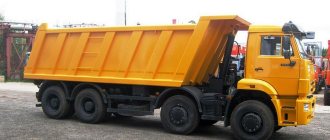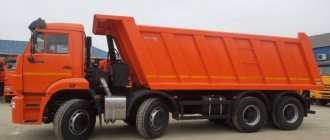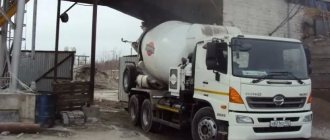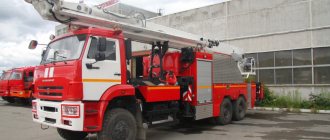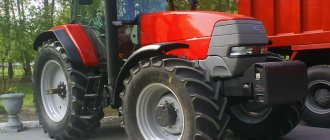Beton-House.com
Website about concrete: construction, characteristics, design. We combine the experience of professionals and private craftsmen in one place
Concrete mixer on KAMAZ chassis
Concrete is by far the most popular building material. Often, due to the remoteness of concrete production plants from the object being concreted and the impossibility of producing solutions directly on the site, it is necessary to resort to transporting the concrete mixture.
To organize its delivery to consumers, as well as to prepare the solution on the way and at its destination, automobile concrete mixers are used. Let's look at what characteristics the equipment on the KAMAZ chassis has, its positive qualities and negative aspects, prices for new cars, and also how you can seriously save money by purchasing a KAMAZ concrete mixer truck: used or from storage.
Concrete mixer truck (concrete mixer) 69363B (ABS-5DA) on KAMAZ-65115 6x4 chassis
Technical characteristics of concrete mixer 69363B (ABS-5DA) on KAMAZ-65115 6x4 chassis
Model 69363B (ABS-5DA) Useful volume of the mixing drum, m 3 5.0 Geometric volume of the mixing drum, no more than, m 3 9.0 Rotation speed of the mixing drum, rpm 0-14 Loading height, mm 3530 Unloading height of concrete mixture , m 0-2 Capacity of the water tank, l 600 Type of drive of the mixing drum, hydraulic from an autonomous engine D-144 Power consumption of the drive of the mixing drum, kW 37 Rate of unloading of the concrete mixture, m 3 /min 1 Weight, kg: - technological equipment 3755 - equipped with 10435 - transported concrete mixture, no more than 10915 - full, no more than 22400 Total weight distribution, kg, no more: - on the front axle 5550 - on the rear bogie 16850 Overall dimensions, mm: (length x width x height) 7500x2500x3500 Maximum speed movement at full load (unloaded), km/h 50 (75) Base chassis: Model KAMAZ-65115 Engine: Model 740.31 (Euro-4) Type diesel with turbocharger Maximum power, l. With. (kW), at 2200 rpm 240 (176)
ABS concrete mixer truck 58147Z, 58147A, useful capacity 7 cubic meters.
Concrete mixer truck 58147С on KamAZ 65115 chassis (6x4)
Concrete mixer truck 69363B (ABS-5DA) manufactured by TIGARBO (K-Shakhtinsky) on KAMAZ-65115 6x4 chassis
Our company provides the most favorable terms of cooperation in the field of supply of cargo and special equipment. You can buy a concrete mixer truck (concrete mixer) and other construction equipment on credit or lease. If you need a reliable concrete mixer based on KamAZ-MAZ, ours offers various models of mixers at the best prices. The quality and reliability of KamAZ-MAZ vehicles has been proven by time.
Questions and answers about concrete delivery by concrete mixer trucks (mixers, ABS)
What volume are mixers (concrete mixers)? In the Moscow region, the most common ones are 7 and 9 cubic meters; machines of 4, 5 and 6 cubic meters are less common; in some places there are even very small mixers with a volume of 2.5 cubic meters.
Outside the city there are often narrow roads with closed turns, and many places cannot be reached by cars with a capacity of more than 5 cubic meters. In Moscow, the volume of cars is from 6 cubic meters (and 6-7 cc cars are not kept everywhere). The main reasons why there are no small mixers:
- due to the large volumes of one-time deliveries, it is unprofitable to keep small concrete mixers,
- small mixers are most often not new, have toxic emissions, and with them there is a greater risk of getting fined,
- In addition, with the tightening of fines for overloading in 2015, many factories switched to delivering incomplete vehicles, and a 5-cubic-meter car can only carry 2-3 cubic meters.
The “Encyclopedia” section provides more detailed information on the products of the leaders of the Russian ABS market, the Tigarbo and TZA companies. Due to lack of demand, companies are reducing the production of small-volume concrete mixers.
What is the length of the hose for concrete mixers (mixers)? Typically the length of the tray (gutter) is from 1.5 to 2 meters. If additional accessories are used, they may be the property of the driver who installed the gutter himself and may require additional payment for its use.
The photo below shows a mixer with a maximum set of trays of 3 sections (1 main and 2 additional). In practice, the gutter most often consists of 1 or 2 sections.
What to do if the standard gutter length is not enough?
- if the distance is up to 5 m: construct an additional gutter (sleeve) yourself (by workers),
- at distances greater than 5 m, the concrete mixture will not flow along the tray on its own due to the low angle. You need to: either use a concrete pump that will deliver concrete over a distance significantly greater than any gutter,
- or hire a large number of workers who will manually (with shovels) drag the mixture along the tray (this option is chosen for pouring into a window or basement, where using a pump is problematic).
Sometimes there are options to use conveyor belts or special wide pipes - but they are quite rare and you should not count on them by default.
What are the sizes of mixers of different sizes? The specific size of a concrete mixer depends not only on the volume of the mixing drum, but also on the brand of chassis on which it is installed. Only the width remains unchanged - 2.55 (large) or 2.50 meters (all other mixers). The average dimensions and number of mixer axes depending on the volume are presented in the table below:
| Volume, m3 | Number of axes | Length, m | Height, m | Width, m | Curb weight, t |
| 4 | 2 | 7,35 | 3,40 | 2,50 | 10 |
| 5 | 3 | 7,40-8,00 | 3,50 | 2,50 | 12 |
| 6 | 3 | 7,80-8,50 | 3,60 | 2,50 | 11,9-13,5 |
| 7 | 3 | 8,20-8,80 | 3,60-3,75 | 2,50 | 12,2-13,9 |
| 8 | 3 | 8,40-9,00 | 3,70-3,85 | 2,50 | 12,8-15 |
| 9 | usually 3 | 8,50-9,20 | 3,70-3,95 | 2,50-2,55 | 13-15 |
| 10 | 4 | 9,30-9,45 | 3,80-4,00 | 2,55 | 15,3-17,2 |
| 11 | 4 | 9,78 | 3,78 | 2,55 | 16,6 |
| 12 | 4 | 9,94-10,36 | 3,82-3,95 | 2,55 | 16,7-19 |
As a rule, the lower value is a mixer based on KAMAZ, the larger value is concrete mixers based on MAZ, Ural or foreign cars (MAN, Mercedes, Iveco, Renault, Ford, Volvo, Scania, Mitsubishi, Hovo, KAMK, Shakman and other brands). Concrete mixers based on all-terrain vehicles (KrAZ, KAMAZ) were not included in the calculation of dimensions.
More detailed information about the dimensions of mixers depending on the manufacturers of the chassis and mixing drum can be found in the “Encyclopedia” section on the pages of the Tigarbo (largest selection) and TZA manufacturers. Other manufacturers do not provide such detailed data.
loaded mixer with concrete weigh Will it be able to travel to my facility? The weight of 1 cubic meter of concrete is 2.4 tons, the weight of a 5 cubic meter mixer is 12 tons, and a 7 cubic meter mixer is a little over 12 tons. Thus, a loaded 5-cubic-meter concrete mixer weighs 24 tons, a 7-cubic-meter concrete mixer weighs 29 tons, and a 9-cubic-meter concrete mixer weighs 35 tons. Due to their heavy weight, concrete trucks require special attention to the road surface. Even if a ZIL arrived at the site with sand (not to mention a passenger car), this does not mean at all that a mixer will be able to drive through it: a ZIL has a total weight of 10-15 tons, while a concrete mixer has 2 times more. You can navigate as follows:
- if there is a hard surface (asphalt, slabs) laid towards the object, the mixer will be able to drive over it. Rolled soil is a hard surface only in dry weather; in rainy weather it can be washed away. If a car cannot enter an object on a paved road, it is the driver’s fault. But there is a note: in some cases, it is not the hardness of the surface that is decisive, but the freedom of space - it is problematic for even a small mixer to drive on narrow roads with closed turns, not to mention large ones,
- grass, soil, snow, sand and crushed stone are not hard surfaces; in some cases driving over them is possible, in others not, you need to navigate according to the specific situation. Since a concrete mixer is expensive and has a high center of gravity with the risk of overturning, the possibility of passage is determined by the driver - the person responsible for the safety of the machine.
Is it possible to deliver concrete using dump trucks - or do you have to use concrete mixer trucks (also called mixers, concrete trucks or concrete mixers)?
According to clause 9.1. GOST 7473-2010 “concrete mixtures are delivered to the consumer by specialized types of transport designed for the transportation of concrete mixtures. By agreement between the manufacturer and the consumer, it is allowed to transport rigid concrete mixtures by dump trucks.” In practice, rigid mixtures are called lean concrete - concrete with a reduced content of cement and a high content of crushed stone. By analogy, there is rich concrete (respectively, with a reduced content of crushed stone and a high content of cement - not used in real practice) and ready-mixed concrete (according to a standard recipe).
Ready-mixed concrete is considered a flexible mixture, for which mobility is standardized (from P1 to P4), lean concrete is considered a rigid and super-rigid mixture (it spreads for a long time or for a very long time under the influence of its own weight, for which rigidity (from Zh1 to Zh4) and super-rigidity (from SZh1) is standardized to SZh3).
Due to its rigidity, when transporting lean concrete in a mixer, there is a very high risk that the concrete will not be able to be dumped out of the barrel, which is why a rule on transportation in dump trucks has been added to GOST. Due to the same risk, road concrete (with mobility P1) is also transported in dump trucks. Therefore, when ordering lean concrete:
- clarify and make sure that there is no misunderstanding in terminology (sometimes lean concrete is called any low-strength concrete, regardless of consistency - and this is incorrect),
- If you figure out that what you need is a hard concrete mixture, don’t be surprised that it is delivered in dump trucks. Moreover, beware of those who offer to deliver it in mixers, because these are usually middlemen (who jeopardize other people's equipment, not their own) or not very experienced employees.
How can I make sure that the mixer contains the exact volume of concrete indicated on the delivery note? A detailed answer to this question is described in a separate article.
How long can it take to unload the mixer? Each manufacturer has its own standard, but for averaging, we can say that 1 cubic meter should be unloaded in no more than 10 minutes; for additional downtime, a fine of 500 to 1000 rubles per hour of downtime is charged.
How is concrete discharged from the mixer? The concrete mixing barrel uses the “Archimedes screw” mechanism. When the barrel rotates clockwise, the concrete moves from one chute to another - but does not spill out of the barrel and still remains in it. But as soon as the barrel begins to rotate counterclockwise, the concrete is unloaded from the barrel, rising from the very bottom to the top.
This video shows a concrete mixer with 1 main and 2 additional chute sections.
Pay attention to the moment of changing the direction of rotation.
I was told that I still need to give the mixer a chance to rinse. What it is? Yes, after pouring, the driver of the concrete mixer washes the gutter so that the remaining concrete does not splash out onto the road or harden on it. A relatively small amount of water is enough for this (
50 l). Carrying out flushing off-site can result in fines, so suppliers often check to see if there is an area where water and concrete residue will remain after flushing.
KamAZ concrete mixer trucks
Concrete mixer trucks, made on the KamAZ basis, are used to transport concrete mixture from the manufacturer to the construction site. By using such a machine, the mortar is also moved along the entire perimeter of the construction site. Thanks to constant rotation, the concrete mixture inside the mixer is maintained in a liquid state. The KamAZ automobile concrete mixer prevents the homogeneity of the solution from being disrupted and does not allow the mixture to be lost during transportation, loading and unloading.
Device
The design features of an automobile concrete mixer are determined by the need to prevent precipitation from entering the finished concrete mixture. The safety and uniformity of concrete is achieved by rotating the drum during movement.
The mixing drum is installed on the KamAZ chassis at an angle of 10 degrees. Special spiral blades are installed inside it. When they rotate in the opposite direction, the concrete mixture is unloaded. Concrete flows out of the container through installed gutters. One of them is installed directly in the concrete mixer, and the second is pulled to the machine at the unloading site. Special pumps can also be used for these purposes.
Benefits of using a mixer
The mixer is an automated concrete mixer that delivers a specified volume of concrete to the workplace. The advantages of mixers are as follows:
- laying with a mixer is carried out over several hours, which reduces the time for construction work;
- the quality of the finished solution from the mixer is higher than that prepared by hand;
- the mixture from the concrete mixer comes out to the required consistency, which simplifies the work of leveling the surface;
- pouring concrete from a mixer is carried out throughout the day, and when making the mixture manually, it may take a week to pour the solution;
- has no difficulties in calculating the amount of the required solution;
- the mixture prepared at the factory contains additives, plasticizers, and modifiers that improve the waterproofing of the building mass;
- obtaining a homogeneous structure by mixing the mixture in a concrete mixer during transportation.
Return to contents
The lineup
The model line includes variations of vehicles that use various models of KamAZ trucks as a basis. This point largely determines the operational potential of the vehicle.
KamAZ 581453
The three-axle concrete mixer has a 6x4 wheel arrangement. The truck is equipped with a hydromechanical drive and a reliable power plant made in Germany. The planetary gearbox was manufactured in Italy. The main functional elements subject to the greatest wear are made using high-strength steel. This moment ensures the overall maximum service life of the machine. The model is designed for use throughout the year. This becomes possible due to the fact that the chassis engine heats the liquid in the water tank with exhaust gases.
Technical characteristics of the KamAZ 581453 concrete mixer:
Disadvantages of solution preparation
Builders who want to save money make the mortar themselves, but completely forget that when laying the mixture in parts, the foundation ends up with worse technical characteristics. The concrete base turns out to be of poor quality due to the fact that stale cement, prepared many hours before its production, is used to lay it.
Construction companies provide concrete mortar, which is made using mixers with a volume of two to ten cubic meters. Manufacturing companies with a large turnover of products use specially designed vehicles to transport concrete mortar. The use of special equipment for transporting the mash increases the cost of the finished mixture.
KAMAZ concrete mixer truck: review of models, their technical characteristics
Concrete is by far the most popular building material. Often, due to the remoteness of concrete production plants from the object being concreted and the impossibility of producing solutions directly on the site, it is necessary to resort to transporting the concrete mixture.
To organize its delivery to consumers, as well as to prepare the solution on the way and at its destination, automobile concrete mixers are used. Let's look at what characteristics the equipment on the KAMAZ chassis has, its positive qualities and negative aspects, prices for new cars, and also how you can seriously save money by purchasing a KAMAZ concrete mixer truck: used or from storage.
Principle of operation
The operator drives the mixer to the materials storage area and places all the raw materials needed for production into the mixing drum with ladle. Then the mixing drum begins to mix all the materials, after the concrete mixing is completed, the operator sends the concrete mixture to the designated construction site, during transportation, the self-propelled concrete mixer will continue to mix the concrete to prevent the concrete mixture from freezing.
Requirements for transporting concrete
Requirements for the transportation of concrete solutions are specified in GOST 7473-2010 “Concrete Mixtures”.
What should be considered when transporting concrete mixtures:
- The solution must be moved in such a way that the possibility of its loss is excluded.
- The possibility of sediment entering the mixture should be eliminated.
- The transportation method must ensure that the mass remains homogeneous.
- The time planned for transportation should not exceed the period during which the properties of the mixture are preserved (mobility and brand strength).
Transporting concrete using truck mixers is an effective way. Even moving it over long distances, it is possible to ensure that the mixture does not separate. Conditions are created that protect the cargo from the effects of sunlight, rain and other atmospheric phenomena.
The use of concrete mixer trucks makes it possible to produce the solution on the way to the construction site. To do this, the required amount of dry components of the mixture and water (in a separate tank) are loaded into the drum.
When approaching the object (30...40 minutes before the finish), the dry ingredients are mixed with water, the concrete solution is ready for use.
Options for calculating the amount of solution
There are several ways to calculate how much concrete will go into the mixer. Each master chooses the most suitable one for him.
Option 1
It does not give exact results - rather, it is an approximate calculation, which is based on the mass of concrete and assumes the personal presence of a specialist at the plant when washing the drum and loading the mixture. Before filling the concrete mixer, it is weighed (net weight), after filling the manipulations are repeated (gross weight). Then the first value is subtracted from the second value and the mass of the loaded material is obtained.
To calculate the number of cubes of mortar in the drum, you need to divide the weight of the concrete on the invoice by the density.
Density indicators:
- 500 kg/m3 – ultra-light concrete, foam concrete
- 500-800 kg/m3 is lightweight concrete
- 1800-2400 kg/m3 – indicator of heavy concrete
Option 2
This method allows you to calculate the volume of the mixture and the total load of equipment on the road surface. One cubic meter of the mixture weighs up to 2.4 tons - which means there are 16.8 tons of concrete in a 7-cubic drum.
The empty weight of a 7m3 truck mixer is 12.4 tons (curb weight), a loaded 7 cc concrete mixer truck weighs 29.2 tons.
Types of concrete mixer trucks
All concrete mixer trucks (ABC) are manufactured on the basis of trucks. General requirements for equipment are formalized in GOST 27339-2016 “Concrete mixer trucks”. To transport solutions, the vehicle is equipped with a mixing drum.
The volume of concrete drums varies from 3 to 15 m3. The inside of the container is equipped with blades for mixing the composition, loading and unloading it. Depending on the type of operation, the blades rotate in different directions.
Mixers installed on truck chassis differ in the following ways:
- Direction of solution unloading. It can be done forwards and backwards.
- Engine type. The mixer operates from an autonomous engine or by taking power from a truck engine.
- Drum drive. It can be mechanical (rarely used nowadays) or hydromechanical.
Most mixer models are equipped with special tray devices for unloading concrete in hard-to-reach places.
Concrete mixers can be installed on specialized chassis, as well as on semi-trailers, which must be aggregated with tractors.
The technical conditions for the production of ABS standardize the following indicators of this special equipment:
- overall dimensions and weight;
- drum volume (geometric and based on concrete solution output);
- mixer rotation speed;
- volume of the water tank heated by the exhaust gases of the chassis engine;
- mixer drive power;
- loading and unloading height, etc.
Concrete mixer trucks (mixers)
What is the volume of mixers (concrete mixer trucks)?
In practice, most often - 5 and 7 cubes, machines with 4 and 6 cubes are less common, somewhere there are even very small mixers with a volume of 2 cubes. Outside the city there are often narrow roads with closed turns, and many places cannot be reached by cars with a capacity of more than 5 cubic meters.
In the city - from 7 cubic meters and above. The main reasons why there are no small mixers:
- due to large volumes of one-time deliveries, it is unprofitable to keep small mixers,
- Small mixers are most often not new, have toxic emissions, and with them there is a greater risk of getting fined.
How much does a mixer with concrete weigh (loaded)?
The weight of 1 cubic meter of concrete is 2.4 tons, the weight of a 5 cubic meter mixer is 11 tons, and a 7 cubic meter is a little over 12 tons. That is, a loaded 5-cubic mixer weighs 23 tons, a 7-cubic mixer weighs 29 tons.
What length are the sleeves of mixers?
Usually - from 1.5 to 2 meters.
If additional accessories are used, they may be the property of the driver who installed the gutter himself and may require additional payment for its use. The website of the mixer manufacturer Tigarbo shows the following photo:
This is the maximum configuration of the gutter with 3 sections (1 main and 2 additional). In practice, they most often consist of 1 or 2 sections.
What size is the mixer that will come to me?
The specific size of the machine depends not only on the volume of the mixing drum, but also on the brand of chassis on which it is installed.
Only the width remains unchanged - 2.55 (large) or 2.50 meters (all other mixers).
The average dimensions and number of mixer axes depending on the volume are presented in the table below:
| Volume, m3 | Number of axes | Length, m | Height, m | Width, m |
| 4 | 2 | 7,35 | 3,40 | 2,50 |
| 5 | 3 | 7,40-8,00 | 3,50 | 2,50 |
| 6 | 3 | 7,80-8,50 | 3,60 | 2,50 |
| 7 | 3 | 8,20-8,80 | 3,60-3,75 | 2,50 |
| 8 | 3 | 8,40-9,00 | 3,70-3,85 | 2,50 |
| 9 | 3 | 8,50-9,20 | 3,70-3,95 | 2,50-2,55 |
| 10 | 4 | 9,30-9,45 | 3,80-4,00 | 2,55 |
As a rule, a lower value is a mixer based on KAMAZ, a larger value is based on a MAZ, Ural or foreign cars. Mixers based on all-terrain vehicles were not included in the calculation of dimensions.
More detailed information about the dimensions of mixers depending on the manufacturers of the chassis and mixing drum can be found in the “Encyclopedia” section on the pages of the manufacturers Tigarbo (the largest selection), TZA, Becema. Other manufacturers do not provide such detailed data.
What to do if the standard gutter length is not enough?
The most commonly used options are to construct the gutter yourself (with workers) or use a concrete pump, which will deliver concrete over a distance much greater than any gutter.
How long can it take to unload the mixer?
Each manufacturer has its own standard, but for averaging, we can say that 1 cubic meter should be unloaded in no more than 10 minutes; for additional downtime, an additional fee of 1,200 rubles per hour of downtime is charged.
How is concrete discharged from the mixer?
The concrete mixing barrel uses the “Archimedes screw” mechanism.
When the barrel rotates clockwise, the concrete moves from one chute to another - but does not spill out of the barrel and still remains in it. But as soon as the barrel begins to rotate counterclockwise, the concrete is unloaded from the barrel, rising from the very bottom to the top.
I was told that I still need to give the mixer a chance to rinse. What it is?
Yes, after pouring, the mixer driver flushes the chute to prevent any remaining concrete from hardening on it.
A relatively small amount of water is enough for this (
Carrying out flushing off-site is fraught with fines, so concrete suppliers check to see if there is a site where water and concrete residues will remain after flushing.
The Buyer is obliged to provide access roads to the facility to which the goods are delivered, allowing for the unhindered unloading (delivery) of goods using the Supplier’s vehicles and special equipment. If access roads to the facility are not provided, the Buyer is obliged to ensure the evacuation of vehicles and special equipment at its own expense and on its own.
The buyer is obliged to provide a place for washing vehicles and special equipment at the construction site.
Automotive concrete mixers KAMAZ
KAMAZ PJSC is a major manufacturer of trucks. The first truck rolled off its assembly line back in 1976.
Currently, the company is trying to keep up with the times, improving its products taking into account environmental standards, ergonomics, and using components in designs developed by recognized luminaries of the automotive industry. A big event was the start of production of trucks with gas engines in Naberezhnye Chelny.
Currently, the concern produces about twenty ABS models, and additional opportunities opened up after joining the group.
What is typical for KAMAZ special equipment:
- Compared to foreign analogues - affordable price.
- Excellent performance characteristics, reliability, service life.
- Adaptability to difficult road and climatic conditions.
- The ability to carry out simple repairs with your own hands.
- Available spare parts and components.
Using this technique, you can easily deliver concrete mortar to a construction site, as well as prepare it directly on site and distribute it around the construction site. If this topic interests you, we suggest you watch the video in this article.
Two-axle ABS are currently not in great demand and the leading ones, KOMZ-Export, which produces products under the Tigarbo brand, including those producing concrete mixer trucks on the KAMAZ chassis, have refused to produce them.
Three-axis models are the most relevant now. They are equipped with mixers with a useful volume of up to 9 m 3 . And here, mixers installed on the KAMAZ chassis are popular due to the budget selling price, cheap spare parts, usually available, and the possibility of self-repair of equipment.
While in this segment it is still possible to compete with the products of Chinese concerns, in the four-axle sector this is becoming increasingly difficult. Let's look at the most popular models of concrete mixers on the KAMAZ chassis.
Concrete mixer truck 58148Y
The concrete mixer is installed on a four-axle chassis. Belongs to the Euro-4 environmental class. This equipment is equipped with a large-capacity drum (up to 8 m3 of finished mixture) and is intended for transporting concrete mixtures to large construction sites. It is fully adapted to the road and climatic conditions of various regions of Russia. Maximum travel speed is 60 km/h.
The base cost of the model is within 4.5 million rubles. An analogue of this concrete mixer is ABS 9DA from KOMZ-Export CJSC, made on a KamAZ chassis.
What characteristics does this TIGARBO concrete mixer truck have:
- KAMAZ 6540 also acts as a chassis;
- the volume of concrete delivered by this mixer has been increased to 9 m 3 ;
- The water tank capacity is 800 l;
- autonomous motor for the mixer;
- The total weight of the ABS reaches 32 tons.
The car shown in the photo costs 4.5 million rubles. There are 9 models of concrete mixer trucks in the line of KOMZ-Export CJSC. However, they do not actively use the KAMAZ chassis, preferring other manufacturers.
Concrete mixer truck 581462
This ABS is installed on a three-axle chassis and belongs to the second environmental class. A little obsolete, not the most powerful in terms of performance (the useful volume of the drum does not exceed 6 m3), but a reliable mixer. The average fuel consumption of a car, depending on the operating mode, varies between 28...31 l/100 km.
The cost of a used mixer is in the range of 850...950 thousand rubles.
Important! A good option for purchasing budget equipment is to purchase it from storage, through conversion. The cost of the models is not much higher than the price of used machines (and often lower), however, these copies have not been in operation and only require maintenance to start working.
Concrete mixer truck 58147A
This machine is designed for operation at temperatures of -20…+40 degrees. To ensure ABS operation at lower levels, a “winter package” is installed. The big advantage of this model is the use of European equipment: the chassis is equipped with a Cummins ISB6.7 300 engine (ecological class 4), and a ZF-9S gearbox is installed.
The hydraulic drive system is equipped with high-quality and reliable components of European and domestic production. The price for such special equipment starts at 3.4 million rubles. A two-year-old used KAMAZ 58147A concrete mixer truck with a mileage of about 50 thousand km can cost 2.3 million rubles.
Capacity of a concrete mixer based on KamAZ
When calculating how many cubes of concrete are in a KamAZ mixer, you can find out what the capacity of a concrete mixer truck (concrete mixer truck, concrete truck) is and how many trucks will be needed to transport the volume of concrete required for construction. The need for transportation is determined by the following factors:
- the concrete solution prepared manually at the construction site has worse quality and technical parameters than the one made in a KamAZ mixer at a specialized plant;
- thanks to the concrete mixer, the solution remains homogeneous, does not separate, does not splash, and does not leak along the way from the plant to the construction site.
What are the advantages of ordering a mixer?
The volume of concrete in the mixer is quite large. All components of the solution are mixed at the factory, loaded into a Kamaz and sent to the site. At the same time, the customer can be sure that the concrete exactly corresponds to the declared grade and all relevant parameters according to GOST. Concrete is delivered to the site in finished form and supplied to the pouring site.
Advantages of using a concrete mixer truck:
- Delivery of freshly prepared mixture directly to the site
- Exact compliance of the brand and technical characteristics with GOST
- Possibility of supplying the solution directly to the formwork
- Significant reduction in the share of manual labor - due to the absence of the need to prepare the mixture yourself and deliver it to the site (the solution is supplied through a chute)
- High speed of work implementation, absence of unnecessary seams, areas with low-quality concreting
- Delivery of concrete to any distance - small and large factories provide the service in Moscow and the regions, with precise adherence to transportation time
Concrete in KamAZ retains mobility, homogeneity, does not dry out and does not delaminate. Many modern models are equipped with pumps and various types of hoses to effectively move the mixture over a distance of several meters or more.
The main advantages of delivering concrete by mixer
Purchasing and transporting concrete mixture in this way has its advantages:
- the ability to transport material over long distances without loss of quality;
- the composition is protected from the effects of negative atmospheric factors (sun, temperature changes);
- prompt provision of mortar for both small construction projects and large-scale objects;
- easy, convenient loading and unloading of the mixture from the drum;
- the ability not only to deliver material, but also to fill the structure;
- savings - simultaneously with mixing the solution, it is delivered, which is cheaper than stationary, factory preparation;
- you can buy ready-made, required volume of material;
- built-in strain gauges monitor the level of concrete filling in the mixer and signal about overflow;
- concrete mixture can be transported in dry or liquid state;
- Due to the fact that the drum of the concrete truck constantly rotates, the solution inside does not harden and does not lose quality during transportation.
Features of the technology
Modern concrete mixers are trucks equipped with a rotating concrete mixer. This allows machines to not only deliver material to a site, but also produce it during transportation. Due to the fact that the solution is constantly in motion due to the rotation of the drum, it does not set, which allows the material to be transported over long distances.
It must be said that the history of the emergence of this construction equipment goes back to the beginning of the last century, however, this equipment became widespread in our country in the post-war period. Of course, a lot of time has passed since then, and the design of the machines has been significantly improved.
As a result, modern concrete mixer trucks have a number of additional functions. In addition, they can be equipped with a device for heating the mixture and thermal insulation, which allows the concrete not to freeze at low temperatures.
Thus, we can distinguish three main purposes of this type of equipment:
- Production of concrete mixtures from dry components during transportation from a special installation to a construction site.
- Preparation of mortar at the construction site.
- Transportation of concrete solution with periodic mixing to the construction site.
Note! Modern concrete mixers can be operated at ambient temperatures from -20 to +40 degrees Celsius.
In the photo - pouring concrete
Advantages
The use of this type of equipment in construction has a number of advantages, among which are:
| Versatility | A concrete truck can provide concrete for both small private construction and large multi-storey buildings. |
| Mobility | As mentioned above, the main advantage of these machines is the ability to transport concrete over long distances. A fully loaded vehicle can travel at a speed of about 60 km/h. Moreover, during transportation the material is not exposed to the environment. |
| Concrete preparation speed | The machine allows you to prepare the solution on the construction site in a short time. |
| Ease of unloading | A concrete truck with a hose can not only deliver the solution, but also pour it into the formwork. |
| Economical | Since the solution is prepared during delivery, its price is lower than when produced on stationary equipment in a factory. |
Advice! If it is impossible to ensure access for equipment to the pouring site, use a special pump to deliver concrete with flexible hoses.
Types of concrete mixers
Concrete mixer trucks come in different types, as they are designed for different construction jobs.
Their main differences are in the following points:
- In the location of the mixing container and the direction of discharge of the solution . Unloading can be done backwards or forwards. In the first case, the operating instructions for the concrete mixer require operator participation during unloading.
If concrete is unloaded backwards, the driver can control this operation with his own hands.
- In concrete mixer drive type . It can be mechanical, hydraulic or hydromechanical. The most popular recently are concrete mixers with hydromechanical transmission, which allows you to adjust the drum speed.
Four-axis model with pump and mixer
- Another important difference between concrete mixer trucks is the volume of the concrete truck mixer, which ranges from 1.5 to 12 cubic meters . For small private construction, a small concrete mixer for several cubes is enough.
If the object is large, then use a concrete mixer with a drum volume of 9-12 cubic meters. In some cases, several machines are used simultaneously to deliver and prepare the solution.
- Also the difference lies in the type of chassis . The mixer can be installed on a truck platform or in the form of a semi-trailer. It should be noted that the number of chassis axles depends on the volume of the tank; for large-volume mixers, three-axle or even four-axle chassis are used.
Note! The larger the tank volume, the greater the height of the concrete truck. You should pay attention to this parameter if the access to the object is limited in height by any obstacles.
The volume of the concrete truck is 9 cubic meters
Indicators affecting mixer capacity
The mixing drums of a concrete truck based on the KamAZ chassis have different capacities. The number of cubes of concrete in KamAZ depends on the model of special equipment and the type of its design. KamAZ concrete mixer trucks are produced with drum volumes from 5 to 12 m 3 .
To supply large construction sites with concrete, special equipment with a capacity of 10–12 m 3 is used. It will be difficult for a vehicle with such a tank volume to enter a small-scale construction site.
It is more advisable to use equipment with a mixing drum of 6–9 m 3. These standard sizes are the most popular and common among private developers.
The KamAZ mixer has an inclination angle. It can vary from 10 to 15 degrees. Due to the inclined position of the container and internal screw blades, complete, convenient unloading and loading of the solution occurs. The presence of a water tank allows you to wash the tank after each drain of the solution. If this is not done, the remaining concrete will harden on the walls and reduce the amount of “usable” mixture of subsequent deliveries.
Criteria for choosing a concrete mixer
The model range of KamAZ concrete mixer trucks includes more than 20 vehicles. Before choosing a specific model, consider the following:
Example of ABS technical characteristics
- Drum volume. The speed of movement of the concrete mixer, the amount of solution loaded into the mixer, and the load on the road surface depend on this indicator.
- Engine power.
- Patency.
- Full weight of the equipment. Not every large and loaded mixer can travel everywhere.
- Drum rotation speed.

